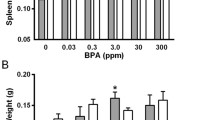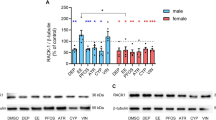Abstract
Four-tert-octylphenol (OP), an environmental pollutant, exerts apoptotic effects on cultured mouse splenocytes. Although OP binds to estrogen receptors, these apoptotic effects are not exerted by 17β-estradiol (E). It remained possible that OP might bind to estrogen receptors and subsequently exert apoptotic effects not exerted by E after it binds to the same receptors. It also remained possible that E-primed splenocytes might respond to OP differently than splenocytes not exposed to E. Thus, we investigated OP and E interactions on the viability of mouse splenocytes in culture. The total number of splenocytes (cells stained and not stained with trypan blue) was not altered or altered slightly after incubation with any agent for 24 h. Incubation of splenocytes in medium containing 5×10−5 or 5×10−7 M OP decreased the percentage of viable cells by approx 47% and 25%, respectively. The addition of 0.8×10−5 to 0.8×10−9 M E to cultures was without effect or decreased the percentage of viable cells by only approx 5%. The addition of these concentrations of E simultaneously with or at 2 h after the addition of 5×10−5 M or 5×10−7 M OP to cultures did not interfere with the OP-induced decreases in cell viability. By contrast, incubation of splenocytes in medium containing E for 2 h prior to the subsequent addition of either dose of OP blocked the OP-induced decreases in cell viability in a dose-response manner. There was a marked reduction in the percentage of viable cells (70%) when splenocytes were incubated with 0.5×10−5 M dexamethasone. The addition of 0.8×10−5 M E at 2 h prior to the addition of dexamethasone did not prevent the decreased cell viability. Incubation of cells in medium with 0.8×10−5 M testosterone caused a small decrease in splenocyte viability similar to that observed with E. However, unlike E, the addition of testosterone at 2 h prior to the addition of 5×10−5 M OP did not prevent the OP-induced decrease in cell viability. These data suggest the presence of estrogen receptors in some splenocytes. They also suggest that if OP binds to these estrogen receptors or other receptors in the absence or initial presence of E, the resulting effect is toxic to the cells. By contrast, exposure of splenocytes to E prior to their exposure to OP can prevent the toxicity of OP.
Similar content being viewed by others
References
Weinberger P., and Rea, M. S. (1982).Environ. Exp. Botany 22, 491–496.
Rantuccio, F., Sinisi, D., Coviello, C., Conte, A., and Scardigno, A. (1984).Contact Dermatitis 10, 212–219.
Lowenheim, F. A. and Moran, M. K. (1975). p-nonylphenol. In:Faith, Keyes, and Clark's Industrial Chemicals, 4th ed. John Wiley & Sons, New York, pp. 575–578.
Synthetic Organic Chemicals, United States Production and Sales (1990). USITC Publication 2470, December 1991, US International Trade Commission, Washington, DC.
Scharer, D. H., Kravetz, L., and Carr, J. B. (1979).Tappi 62, 75–78.
Giger, W., Brunner, P. H., and Schaffner, C. (1984).Science 225, 623–625.
Giger, W., Ahel, M., Koch, M., Laubscher, H. U., Schaffner, C., and Schneider, J. (1987).Water Sci. Tech. 19, 449–460.
Gaffney, P.E. (1976).J. Water Pollut. Control Fed. 48, 2731–2737.
Sundaram, K. M. S. and Szeto, S. (1981).J. Environ. Sci. Health 16, 767–776.
Knaak, J. B., Eldridge, J. M., and Sullivan, L. J. (1966)Toxicol. Appl. Pharm. 9, 331–340.
McLeese, D. W., Zitko, V., Sergeant, D. B., Burridge, L., Metcalfe, C. D. (1981)Chemosphere 10, 723–730.
Shiraishi, H., Carter, D. S., and Hites, R. A. (1989)Biomed. Environ. Mass Spectrom. 18, 478–483.
Stephanou, E. and Giger, W. (1982).Environ. Sci. Technol. 16, 800–805.
Ahel, M., Conrad, T., and Giger, W. (1987).Environ. Sci. Technol. 21, 697–703.
Rivera, J., Ventura, F., Caixach, J., De Torres, M., and Figueras, A. (1987).Int. J. Environ. Anal. Chem. 29, 15–35.
Naylor, C. G., Mieure, J. P., Adams, W. J., Weeks, J. A., Castaldi, F. J., Ogle, L. D., and Romano, R. R. (1992).J. Am. Oil Chemists Soc. 69, 695–703.
Clark, L. B., Rosen R. T., Hartman, T. G., Louis, J. B., Suffet, I. H., Lippincott, R. L., and Rosen, J. D. (1992).Int. J. Environ. Anal. Chem. 47, 167–180.
Zoller, U. (1993).Water Sci. Tech. 27, 187–194.
Ahel, M., Giger, W., and Schaffner, C. (1994).Water Res. 28, 1143–1152.
Blackburn, M. A., and Waldock, M. J. (1995).Water Res. 29, 1623–1629.
Nair-Menon, J. U., Campbell, G. T., and Blake, C. A. (1996).Toxicol. Appl. Pharm. 139, 437–444.
Jobling, S. and Sumpter, J. P. (1993).Aquatic Toxicology 27, 361–372.
White, R., Jobling, S., Hoare, S. A., Sumpter, J. P., and Parker, M. G. (1994).Endocrinology 135, 175–182.
Blake, C. A. and Boockfor, F. R. (1996).Mol. Biol. Cell,Suppl. to 7, Abstract 3843.
Boockfor, F.R. and Blake, C.A. (1996).Mol. Biol. Cell,Suppl. to 7, Abstract 729.
Arnold, S. F., Klotz, D. M., Collins, B. M., Vonier, P. M., Guillette L. J., Jr., and McLachlan, J. A. (1996).Science 272, 1489–1492.
Olsen, N. J. and Kovacs, W. J. (1996).Endocr. Rev. 17, 369–384.
Yang, N. N., Venugopalan M., Hardikar, S., and Glasebrook, A. (1996).Science 273, 1222–1225.
Author information
Authors and Affiliations
Additional information
A portion of this work has been published in abstract form in Molecular Biology of the Cell, Supplement to Vol. 7, 1996, Abstract 3843.
Rights and permissions
About this article
Cite this article
Blake, C.A., Nair-Menon, J.U. & Campbell, G.T. Estrogen can protect splenocytes from the toxic effects of the environmental pollutant 4-tert-octylphenol. Endocr 6, 243–249 (1997). https://doi.org/10.1007/BF02820499
Received:
Revised:
Accepted:
Issue Date:
DOI: https://doi.org/10.1007/BF02820499




